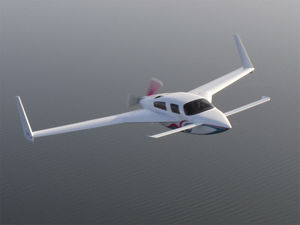
- Aircraft
- Aircraft
- Tourist aircraft
- Velocity

- Products
- Catalogs
- News & Trends
- Exhibitions
Tourist aircraft V-TWINtwin-engineturboprop4-seater

Add to favorites
Compare this product
fo_shop_gate_exact_title
Characteristics
- Applications
- tourist
- Number of engines
- twin-engine
- Motorization
- turboprop
- Number of places
- 4-seater, 5-seater, 7-seater
- Category
- light
- Other characteristics
- kit, biplane
- Cruise speed
Max.: 250 kt
Min.: 185 kt
- Max. take-off weight
Max.: 3,440 lb
(1,560 kg)Min.: 3,200 lb
(1,451 kg)- Fuel capacity
Max.: 100 gal
Min.: 90 gal
- Length
22'00"
(6.71 m)- Height
7'00"
(2.13 m)
Description
The Velocity V-Twin was designed to provide a safe and efficient transportation aircraft especially for those who fly at night, over mountains, over large bodies of water, serious IFR and those who just want the redundancy of a second engine to get them home or to an airport in the event of an engine failure. One of the design goals was to provide a twin engine aircraft that does NOT have the “stall/spin” problems associated with most twin engine aircraft. Think of it this way: Should you lose one engine of a conventional twin during the most critical departure point when the airspeed is low and in a climb attitude, panic will set in and often the pilot will not initiate the essential elements of an engine out procedure. He now finds that it takes full rudder to keep the airplane from yawing, airspeed is decaying and a turn back to the runway can result in the lowered wing to stall. Not much different than most airplanes where you use full rudder and slow the airplane down to a stall resulting in a spin. Key decisions used in a twin are: “identify,” “verify,” and “secure.” Identify the engine that failed by using the dead foot, dead engine terminology, verify by retarding the throttle that represents the dead engine and then secure the dead engine by feathering the propeller and shutting off the fuel to that engine. Struggling all at the same time to maintain a safe flying speed and keeping the airplane from crashing into the trees or other obstacles on the departure path.
VIDEO
*Prices are pre-tax. They exclude delivery charges and customs duties and do not include additional charges for installation or activation options. Prices are indicative only and may vary by country, with changes to the cost of raw materials and exchange rates.


